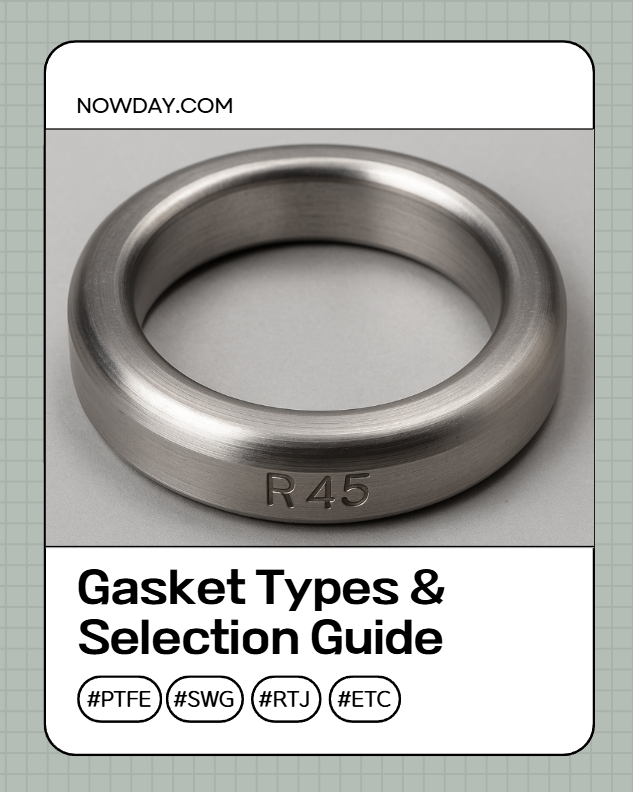
1. Introduction
In any piping system, a flange is only as good as the gasket between them.
A poorly selected gasket can lead to leakage, blowout, or chemical attack — even if the flanges are perfectly aligned.
This guide explains the major types of gaskets, their materials, and how to select the right one for your operating conditions.
2. What Is a Gasket?
A gasket is a sealing element placed between two flanges to prevent leakage of fluid or gas under compression.
It compensates for flange surface irregularities and maintains tightness under pressure and temperature fluctuations.
Primary Functions:
- Maintain a seal under varying pressure and temperature.
- Compensate for minor flange misalignments.
- Resist chemical or thermal degradation over time.
3. Main Gasket Categories
| Type | Description | Typical Pressure Range | Common Material | Application |
| Non-Metallic | Soft materials compressed easily | Low–Medium | Rubber, PTFE, Graphite | Water, air, chemical lines |
| Semi-Metallic | Combination of soft and metal layers | Medium–High | Spiral wound, Metal jacketed | Steam, oil, refinery lines |
| Metallic | Solid metal construction | High–Extreme | SS, Inconel, Copper | High pressure, high temperature |
4. Non-Metallic Gaskets

4.1. Compressed Fiber Gasket
Made from aramid or graphite fibers bound with elastomers.
Ideal for water, oil, or low-pressure steam.
Pros: Cheap, flexible, easy to cut.
Cons: Limited to about 400°F (200°C).
Example: Garlock Blue-Gard, Klinger C-4400.
4.2. PTFE Gasket

Chemically inert and ideal for corrosive environments.
Often used in chemical, food, and pharmaceutical industries.
Pros: Excellent chemical resistance, wide temperature range.
Cons: Cold flow under high pressure; not suitable for heavy bolts.
Max Temp: 260°C.
4.3. Graphite Gasket
Excellent for thermal cycling and high-temperature service.
Often reinforced with stainless steel foil for added strength.
Pros: Resists oxidation and pressure cycling.
Cons: Brittle and can crumble if mishandled.
Max Temp: Up to 450°C.
5. Semi-Metallic Gaskets
5.1. Spiral Wound Gasket (SWG)


The most widely used type in industrial piping.
Formed by winding metal (usually SS 304/316) and soft filler (graphite/PTFE) alternately.
Pros: Handles wide range of pressure and temperature.
Cons: Requires precise flange surface and bolt load.
Standard: ASME B16.20.
5.2. Metal Jacketed Gasket
Soft filler material enclosed by a thin metal jacket.
Common in heat exchangers and vessel manways.
Pros: Good chemical resistance, high mechanical strength.
Cons: Not reusable; requires smooth flange faces.
6. Metallic Gaskets

6.1. Ring Type Joint (RTJ)
A precision-machined metal ring used in high-pressure flanged joints (API, ASME B16.20).
The gasket sits in a groove on each flange and provides metal-to-metal sealing.
Shape Types:
- R type (Oval, Octagonal) – standard for ASME 1500–2500#
- BX, RX type – for API flanges (up to 20,000 psi)
Pros: Excellent sealing at extreme pressures.
Cons: Requires precise alignment and surface finish.
7. Gasket Selection Criteria
| Parameter | Consideration |
| Pressure & Temperature | Choose metallic or semi-metallic for high-pressure systems. |
| Media Compatibility | PTFE for chemicals, Graphite for steam, Rubber for water. |
| Flange Type | RF or FF flanges use soft gaskets; RTJ flanges require metallic rings. |
| Bolt Load | Ensure sufficient compression without damaging soft gaskets. |
| Reusability | PTFE and Graphite can be reused in low-stress applications; Spiral Wound and RTJ cannot. |
8. Field Tips
- Always match gasket size and standard to the flange (ASME 150# vs 300#).
- Avoid over-tightening soft materials like PTFE — they deform easily.
- For corrosive or mixed-service lines, consider PTFE envelope gaskets (PTFE outer + graphite inner).
- Never reuse a metallic gasket after disassembly unless manufacturer allows it.
9. Common Failures and Causes
| Failure Type | Likely Cause |
| Blowout | Under-tightened bolts or soft gasket under high pressure |
| Leakage after startup | Uneven bolt torque or flange misalignment |
| Chemical degradation | Wrong material selection (e.g., NBR in acid line) |
| Oxidation damage | Graphite gasket exposed to high oxygen flow |
10. Conclusion
The gasket is often the smallest and cheapest part of a piping system — yet the first one to fail when chosen wrong.
Always verify the standard, pressure rating, and material compatibility before installation.
When in doubt, consult the ASME B16.20 / B16.21 standards for selection limits and recommended torque.
Flange Types and Their Applications – Weld Neck, Slip-On, Blind, Socket Weld, Threaded, Lap Joint
Flanges may look simple, but each type has a specific role in how a piping system handles pressure, temperature, and vibration. Using the wrong flange type can lead to leaks, misalignment, or even catastrophic failure.This guide explains the most common fl
www.nowdaylab.com
Flange Standards & Dimension Chart – ASME / JIS / DIN Comparison
1. ANSI / ASME B16.5 – Class 150 (RF Type)(Reference: ASME B16.5-2020)2. JIS B2220 – 10K Flange Dimensions(Reference: JIS B2220-2019)3. DIN EN 1092-1 – PN16 Flange Dimensions(Reference: DIN EN 1092-1:2018)7. Size Conversion (ASME / JIS / DIN) ASME (i
www.nowdaylab.com
Pressure Vessel Testing & Inspection – What Really Happens on Site
Here’s the truth:You can have the best drawings, the cleanest welds, and still end up with a ticking bomb if your testing is sloppy.Pressure vessel testing isn’t paperwork. It’s the part where you find out if what’s on paper actually holds pressure
www.nowdaylab.com